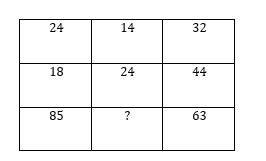Question
Statements: Some reds are
blues. All blues are greens. Some greens are not yellows. Conclusions: I. Some yellows are reds. II. Some yellows are blues. III. Some greens are reds. In each of the questions below are given three statements followed by three conclusions numbered I, II and III. You have to take the given statements to be true even if they seem to be at variance with commonly known facts. Read all the conclusions and then decide which of given conclusions logically follows from the given statements disregarding commonly known facts.Solution
Some reds are blues (I) + All blues are greens.(A) = Some reds are greens.(I) ⇒ conversion ⇒ Some greens are reds (I) Hence, conclusion III follows.
Select the option that is related to the third number in the same way as the second number is related to the first number.
15 : 5 :: 26 : (?)
Study the given matric carefully and select the number from among the given options that can replace the question mark (?) in it.
What will come in the place of question mark?
Find the missing term in the following series:
43 44 ? 69 185
...Study the given pattern carefully and select the number that can replace the question mark (?) in it.
First row: 14, 17, 40
Second row: 52...
Choose the correct alternative that will complete the given number series. 2, 9, 28, 65, ?, 217
Select the number from among the given option that can replace the question mark (?) in the following series.
4, 21, 86, 261, 526, ?
Select the missing number from the given responses.

Select the related number from the given alternatives.
29 : 65 : : 43 : ?

Relevant for Exams:


